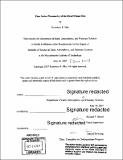| dc.contributor.advisor | Richard P. Binzel. | en_US |
| dc.contributor.author | Pike, Rosemary Ellen | en_US |
| dc.contributor.other | Massachusetts Institute of Technology. Department of Earth, Atmospheric, and Planetary Sciences. | en_US |
| dc.date.accessioned | 2018-03-27T14:18:01Z | |
| dc.date.available | 2018-03-27T14:18:01Z | |
| dc.date.copyright | 2007 | en_US |
| dc.date.issued | 2007 | en_US |
| dc.identifier.uri | http://hdl.handle.net/1721.1/114335 | |
| dc.description | Thesis: S.B., Massachusetts Institute of Technology, Department of Earth, Atmospheric, and Planetary Sciences, 2007. | en_US |
| dc.description | Cataloged from PDF version of thesis. | en_US |
| dc.description | Includes bibliographical references (page 29). | en_US |
| dc.description.abstract | This project utilizes time series photometry to attempt to find the period of the newly discovered Kuiper Belt Object (KBO), Eris. Eris is known to have a radius slightly larger than Pluto and an extremely high albedo of 86%, indicative of fresh surface ices. This high albedo makes it likely that the brightness variations of Eris are small and difficult to detect. The data for this project were collected using the Swift Ultra Violet Optical Telescope (UVOT) over 29 nights. The 266 good images were analyzed using aperture photometry on Eris and 33 reference stars. A least squares fit was applied to correct for changes in overall image brightness, and Eris' magnitude was plotted over time. A periodogram was used to search for a periodic solution, but did not yield a significant signal. This means that the rotation period of Eris was below the detection limit of the data, so this detection limit was calculated. For a 6 hour period, the data would have had a 2 sigma significance for a full amplitude of 0.16 magnitudes, a 12 hour period is 0.125 magnitudes, an 18 hour period is 0.155 magnitudes, and a 24 hour period is 0.185 magnitudes. Knowing the detection limit of this data set helps to constrain future observations. In order to determine a period for Eris, new data would have to be more sensitive than these magnitude change detection limits. These results also make the 5-day period proposed by Carraro et al. (2006) unlikely, as this data set shows no periodogram peaks at that frequency. | en_US |
| dc.description.statementofresponsibility | by Rosemary E. Pike. | en_US |
| dc.format.extent | 29 pages | en_US |
| dc.language.iso | eng | en_US |
| dc.publisher | Massachusetts Institute of Technology | en_US |
| dc.rights | MIT theses are protected by copyright. They may be viewed, downloaded, or printed from this source but further reproduction or distribution in any format is prohibited without written permission. | en_US |
| dc.rights.uri | http://dspace.mit.edu/handle/1721.1/7582 | en_US |
| dc.subject | Earth, Atmospheric, and Planetary Sciences. | en_US |
| dc.title | Time series photometry of the dwarf planet Eris | en_US |
| dc.type | Thesis | en_US |
| dc.description.degree | S.B. | en_US |
| dc.contributor.department | Massachusetts Institute of Technology. Department of Earth, Atmospheric, and Planetary Sciences | |
| dc.identifier.oclc | 1028749228 | en_US |
